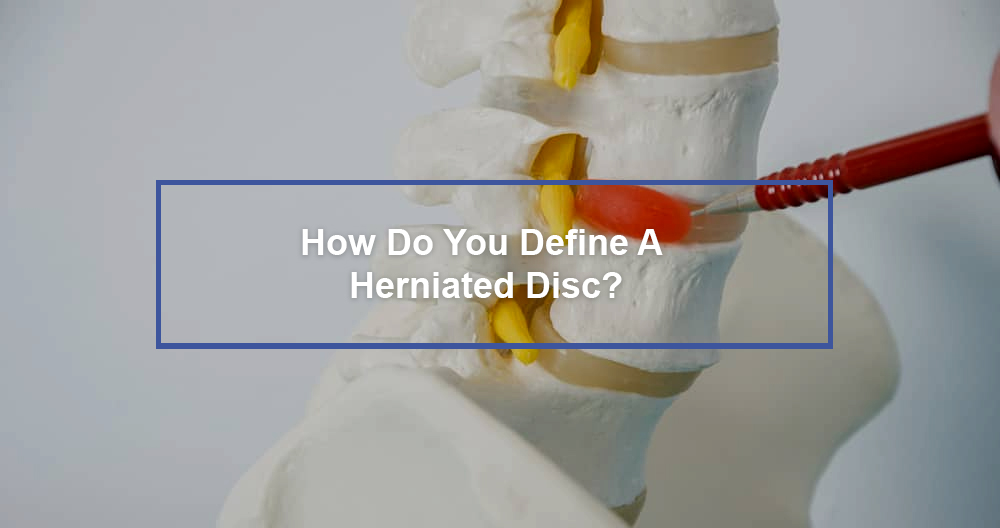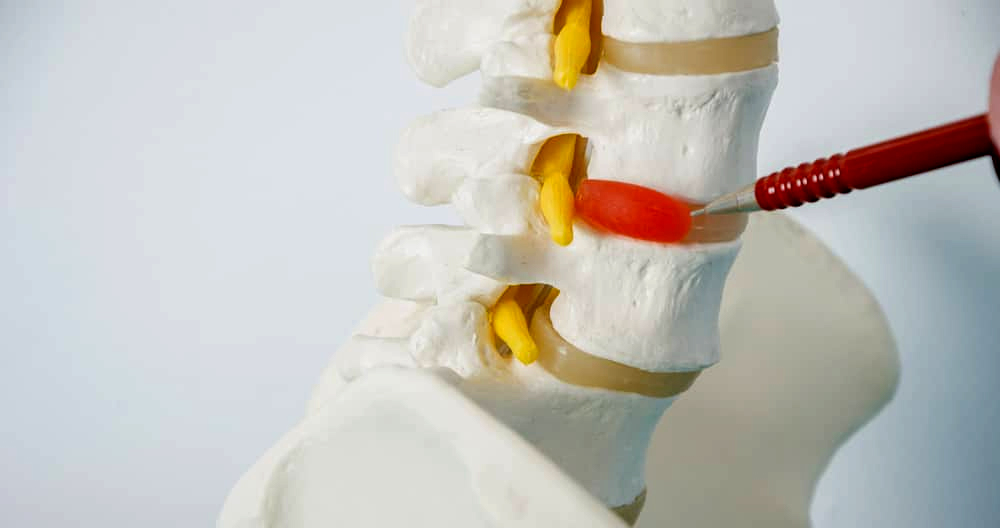
A herniated spinal injury is an injury to your spine (backbone). There are several vertebrae that run from the base of your skull to your tailbone. There are also discs. These are small cushions that sit between the vertebrae. These discs act as a cushion between your bones. These discs allow you to move and bend freely. A herniated disc is a ruptured or leaking disc.
Are herniated discs common?
Up to 2% of people are affected by a herniated disc each year. Herniated discs can lead to neck, arm, back, leg, or sciatica pain. Anywhere along the spine can develop herniated discs. They are most common in the neck and lower back. Herniated discs rarely occur in the middle of the back.
Who gets herniated discs?
The most common age group for a herniated disc is between 30 and 50. This problem is twice as common in men than in women.
- Sitting still for long periods.
- Being overweight.
- Lifting heavy objects.
- Repetitive bending and twisting movements in order to do work, hobbies, or sports.
- Smoking.
Herniated Disc Symptoms
Most often, herniated discs occur in the lower back. They can also be found in the neck. The location and extent of the disc’s pressure on nerves will determine the symptoms and signs. Herniated discs usually affect only one side.
Arm pain and leg pain. Pain can be caused by a herniated disc in your lower back.
If your cervical disc is herniated, you will feel the most pain in your shoulder and arm. If you cough, sneeze or move in certain positions, you might feel pain in your arm and leg.
Tingling and numbness. Radiating numbness or tingling can be caused by a herniated disc.
Weakness. Affected nerves can cause weakness in the muscles that serve them. This can cause you to stumble and limit your ability to lift or hold things.
You can have a herniated spine disc without any symptoms. It is possible to have a herniated spinal disc that is not apparent on a scan.
Herniated Disc Causes
A progressive, aging-related wear can lead to disc herniation. As we age, our discs become less flexible and more likely to rupture or tear with slight strain.
Many people don’t know the cause of their herniated disc. A herniated disc can be caused by lifting heavy objects with your back muscles rather than your leg muscles or thighs. This can also be caused by twisting and turning when lifting. It is rare that it is a traumatizing event such as a fall, or a blow to the back that causes the problem.
Herniated Disc Risk factors
There are many factors that could increase your chances of having a herniated disc.
- Body weight. Extra weight places extra strain on the lower back.
- Occupation. Back problems are more common in those who work physically demanding jobs. If you lift, pull, push, bend sideways, twist, or do repetitive lifting, the risk of a herniated disc may rise.
- Genetics. Some people inherit a predisposition for developing a herniated distal disc.
- Tobacco use. Tobacco use can cause discs to become less efficient and eventually stop working.
- Frequent driving. You can put pressure on your spine by sitting for long periods and vibrating from the motor vehicle engine.
- Being sedentary. Regular exercise can help to prevent a herniated or bulging disc.
Herniated Disc Complications
The spinal cord is located just above your waist. Your waist is where the spinal canal ends. Here you’ll find long nerve roots that look similar to a horse’s tail (cauda Equina span>).
In rare cases, disc herniation can compress the entire spine canal and all nerves. In rare cases, emergency surgery may be necessary to prevent paralysis or permanent weakness.
Get emergency medical attention if:
- Worsening symptoms. You may experience numbness or weakness that can lead to pain and other symptoms that can interfere with your daily life.
- Bladder problems and bowel dysfunction. Cauda Equina Syndrome can cause incontinence or difficulty urinating.
- Saddle anesthesia. The gradual loss in sensation can affect areas that could touch a seat, such as the inner thighs, back, and area around the rectum.
How can I avoid a bulging or herniated disc?
Sometimes a herniated disc can be avoided, but not always. You can decrease your chances of having a herniated disc.
- Proper lifting techniques are essential. Your waist should be straight. Keep your back straight. To support the load, your leg muscles can be used.
- It is important to maintain a healthy weight. An excess weight can put pressure on the lower back.
- Proper posture is crucial. Your posture can be improved by standing, sitting, and walking. Good posture reduces strain on your spine.
- Structuring.
- High-heeled shoes are not recommended. High-heeled shoes can cause your spine to become out of alignment.
- Exercise regularly.
- Stopping smoking. Smoking can cause disc damage and increase vulnerability to rupture. Consider quitting smoking.
Non-Surgical Treatments
First, a herniated disc is treated with nonsurgical and conservative treatment. The doctor might recommend that the patient keep their activity to a minimum for a few days, or even several weeks. This will allow the spine nerve inflammation to decrease. Not recommended: Bedrest
Nonsteroidal anti-inflammatory medication (NSIM) can be used to treat herniated discs if the pain isn’t severe or moderate. A spinal needle equipped with X-ray guidance can be used to administer epidural steroids. The medication will be adjusted to the extent of disc herniation.
The doctor might recommend physical therapy. The therapist will perform a detailed evaluation. The doctor will also be able to determine a treatment plan for patients with herniated backs. Gentle massage, pelvic manipulation and heat therapy are some of the options. Pain medication and muscle relaxants may be included in physical therapy.
Surgery
A doctor might recommend surgery if other options, such as medication and physical therapy, fail to alleviate or eliminate the pain. Discussing surgical options with patients is the best way to determine the best course of action.
It is important to weigh the potential risks of surgery against its benefits. Patients suffering from herniated discs can get significant pain relief through surgery. But, it is not a guarantee that the surgery will work.
If a person is:
- Radicular Pain Limits normal activity, impairs quality of life
- Progressive neurological impairments, such leg weakness and/or paralysis, can develop.
- Normal bowel and bladder functions
- Standing and walking difficult
- Both medication and physical therapy are ineffective
- The patient’s health is good
Lumbar Spine Surgery
Lumbar laminotomy (also known as lumbar lumbar laminotomy) is a procedure to relieve leg pain and sciatica caused by a bulging or herniated disc. The procedure involves making small incisions along the spine and focusing on the affected area. The procedure might involve the removal or a portion of the lamina. The surgeon will cut through the skin and move the muscles to one side to view the back of each vertebrae. Access to the herniated disc is made through a small opening in between the vertebrae. After discectomy, stabilization may be necessary. Sometimes, laminotomy or spinal fusion can be combined. For more complex cases, laminectomy may be performed.
To remove the disc and to replace it, an incision is made through the abdomen. Artificial disc surgery is only available to a select few patients. One disc can only be removed from a patient’s spine. It must be between L4 and L5, or between S5 and S1 (the first sacral vertebra). Patients must have received at least six months’ worth of treatment, including pain medication, physical therapy or a back brace. The patient must be in good physical condition, without any signs or symptoms of osteoporosis or arthritis. If the patient has severe leg pain or disc degeneration, they cannot be considered for this procedure.
Cervical Spine Surgery
The surgeon’s preference and the exact location of the herniated disc will influence the choice of whether surgery is done at the back or front of your neck. Some lamina may be removed by laminotomy. A posterior approach involves removing disc herniation. A posterior procedure does not require fusion. Anterior surgery requires stabilization. Instrumentation can be achieved using a cervical plate or interbody device, and screws (or other instruments). A few candidates might choose to have an artificial cervical disc instead of fusion.
How can I relieve herniated distal pain at home?
Most cases of bulging or herniated discs will resolve over time. These methods can be used to relieve the pain while your disc heals.
- You can rest for up to three nights if the pain is severe. To avoid stiffness, it is important to not stay in bed too long.
- Use an over-the-counter pain reliever such as acetaminophen or ibuprofen.
- Heat/ice may be applied to the affected areas.
What do I need for spinal surgery?
Most herniated discs will heal on their own. 9/10 people are able to get non-surgical treatment. Your healthcare provider may recommend surgery if you are unable to find relief from your symptoms using other treatments. There are many surgical options available to relieve nerve pressure and pressure on the spine.
- discectomy for removing herniated disc.
- Laser laminectomy is used to remove bone from herniated discs.
- Artificial disc surgery is used to replace a damaged or herniated disc.
- Spinalfusion refers to the joining of two or more vertebrae together in order to improve stability.
What is the outlook for herniated disc patients?
Most herniated disc problems can be treated by the patient or simply with medical attention. You’ll feel much better in a few months. If you feel the same after a month, consult your healthcare provider. You may need to have spinal injections or surgery for more serious conditions.
If a herniated bowel gets worse…
Untreated herniated discs can cause more problems. If you continue to do the same things that caused it, like your job, it is possible for a herniated disc to become worse. A ruptured disc can cause chronic (or ongoing) pain that could result in permanent loss of control over the affected area. Contact your healthcare provider if symptoms persist despite conservative treatment.

